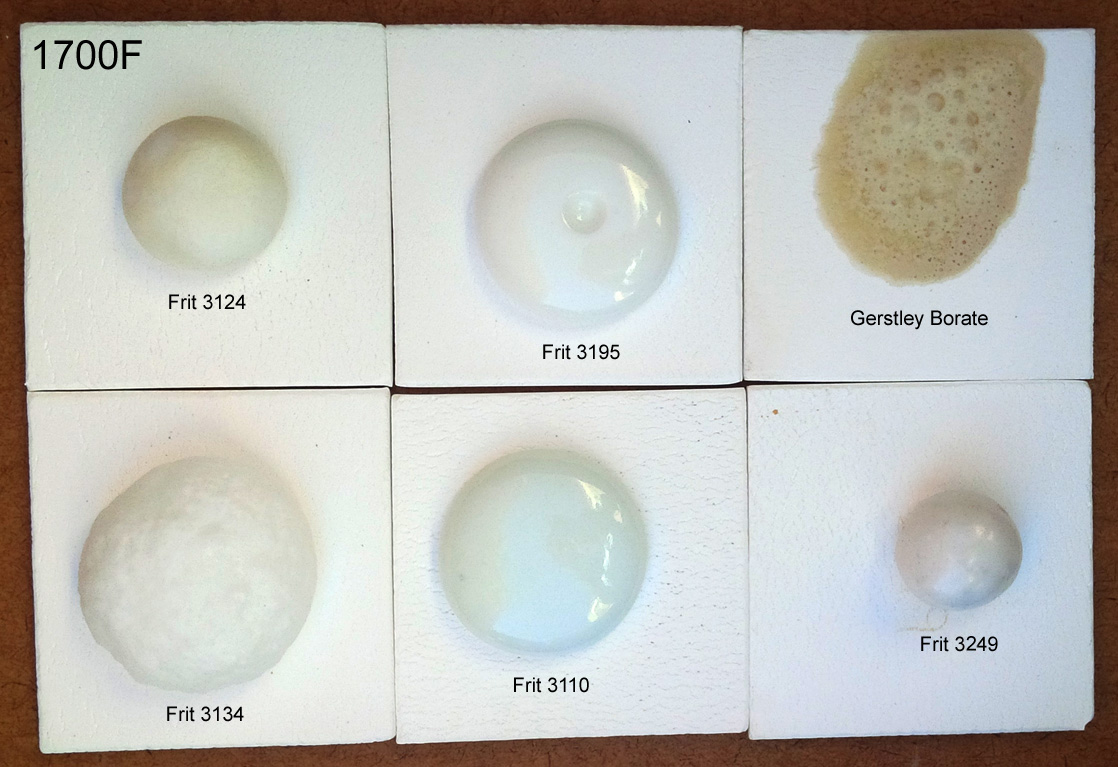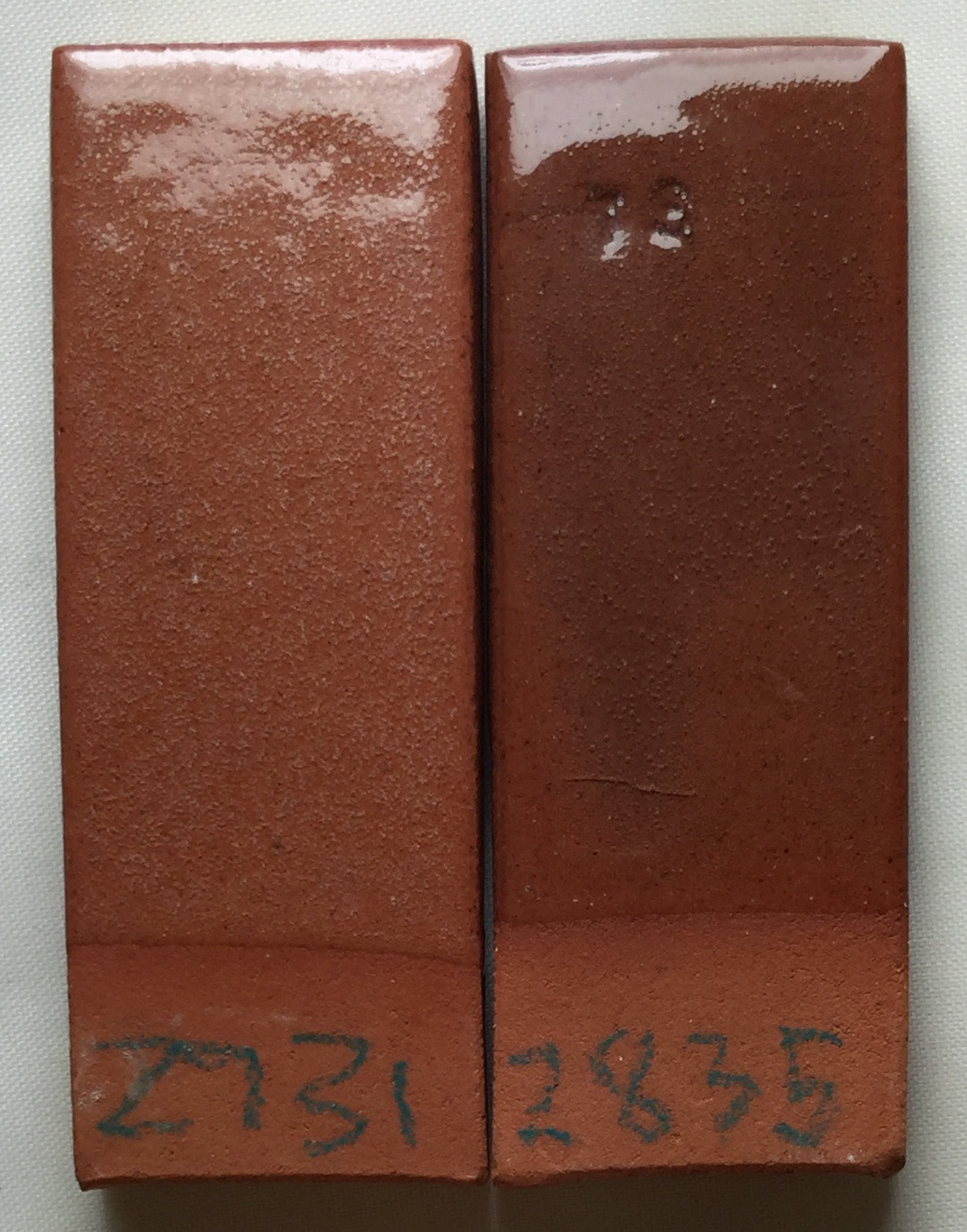| Monthly Tech-Tip | No tracking! No ads! | |
Boron Frit
Most ceramic glazes contain B2O3 as the main melter. This oxide is supplied by great variety of frits, thousands of which are available around the world.
Key phrases linking here: boron frit - Learn more
Details
This term is very generic, referring of course to frits that contain boron. Unfortunately that is 80-90% of available frits! Boron frits may have 1% boron or 50% boron. Even though the boron in the frit is no longer in the borax form it is still customary to refer to such as "borax frits". Since many textbooks call for a generic borax frit in certain glaze recipes it can be very difficult to determine what frit to use. However many technicians agree that the common frit formula of Ferro 3134 is what is intended by the generic term 'borax frit'. This frit is not a glaze-by-itself like 3124 or 3195, it is intended to melt at a very low temperature and as a way to add borax without alumina.
Raw sources of boron (like Borax) are soluble and thus not suitable in glazes (which are suspensions of particles). There are some raw mineral sources, like Gerstley Borate, Colemanite and Ulexite. However these materials have various issues that must be tolerated to use them effectively, normally only potters are able to negotiate these.
Related Information
Your boron glaze might melt alot earlier than you think

This picture has its own page with more detail, click here to see it.
The porcelain mug on the left is fired to cone 6 with G2926B clear glossy glaze. This recipe only contains 25% boron frit (0.33 molar of B2O3). Yet the mug on the right (the same clay and glaze) is only fired to cone 02 yet the same glaze is already well melted! What does this mean? Industry avoids high boron glazes (they consider 0.33 to be high boron) because this early melting behavior means gases cannot clear before the glaze starts to melt (causing surface defects). For this reason, fast fire glazes melt much later. Yet many middle temperature reactive glazes in use by potters have double the amount of B2O3 that this glaze has!
These common Ferro frits have distinct uses in traditional ceramics

This picture has its own page with more detail, click here to see it.
I used Veegum to form 10 gram GBMF test balls and fired them at cone 08 (1700F). Frits melt really well, they do have an LOI like raw materials. These contain boron (B2O3), it is a low expansion super-melter that raw materials don’t have. Frit 3124 (glossy) and 3195 (silky matte) are balanced-chemistry bases (just add 10-15% kaolin for a cone 04 glaze, or more silica+kaolin to go higher). Consider Frit 3110 a man-made low-Al2O3 super feldspar. Its high-sodium makes it high thermal expansion. It works really well in bodies and is great to make glazes that craze. The high-MgO Frit 3249 (made for the abrasives industry) has a very-low expansion, it is great for fixing crazing glazes. Frit 3134 is similar to 3124 but without Al2O3. Use it where the glaze does not need more Al2O3 (e.g. already has enough clay). It is no accident that these are used by potters in North America, they complement each other well (equivalents are made around the world by others). The Gerstley Borate is a natural source of boron (with issues frits do not have).
Frits melt so much more evenly and trouble free

This picture has its own page with more detail, click here to see it.
These two specimens are the same terra cotta clay fired at the same temperature (cone 03) in the same kiln. The chemistry of the glazes is similar but the materials that supply that chemistry are different. The one on the left mixes 30% frit with five other materials, the one on the right mixes 90%+ frit with one other material. Ulexite is the main source of boron (the melter) in #1, it decomposes during firing expelling 30% of its weight as gases (mostly CO2). These create the bubbles. Each of its six materials has its own melting characteristics. While they interact during melting they do not mix to create a homogeneous glass, it contains phases (discontinuities) that mar the fired surface. In the fritted glaze all the particles soften and melt in unison and produce no gas. Notice that it has also interacted with the body, fluxing and darkening it and forming a better interface. And it has passed (and healed) most of the bubbles from the body.
One reason why frits are such a good source of boron

This picture has its own page with more detail, click here to see it.
These two glazes have very similar chemistries (except that G2931G has a much lower SiO2 content, which is why it is melting better). Left: 0.75 molar boron is being sourced by a high-quality frit in G3879C, Fusion Frit F-524. Right: Ulexite is sourcing the same 0.75 boron. Ulexite is a natural material (it is mostly ulexite, but does have other contaminants). Unlike the frit, it contains volatiles that produce an LOI on firing, these gases are generated during the melting phase, producing obvious bubbling.
Inbound Photo Links
 High B2O3 imparts better melt fluidity, but also fewer micro-bubbles |
Links
| Materials |
Ferro Frit 3134
A frit with 23% B2O3. The most common of frits used in pottery in North America. Around the world, other companies make frits of equivalent chemistry. |
| Materials |
Boron Frits
|
| Materials |
Ulexite
A natural source of boron, it melts at a very low temperature to a clear glass. |
| Materials |
Gerstley Borate
Gerstley Borate was a natural source of boron for ceramic glazes. It was plastic and melted clear at 1750F. Now we need to replace it. How? |
| Materials |
Colemanite
A natural source of boron that melts at a very low temperature. |
| Glossary |
Borate
Borate glazes, those fluxed with the oxide B2O3, are the most common type used in ceramic industry and hobby for low and medium temperatures. |
| Glossary |
Base Glaze
Understand your a glaze and learn how to adjust and improve it. Build others from that. We have bases for low, medium and high fire. |
| Glossary |
Medium Temperature
These are stoneware glazes that fire in the range of 1200C (2200F). They often contain boron to assist with melting. |
| Glossary |
Frit
Frits are used in ceramic glazes for a wide range of reasons. They are man-made glass powders of controlled chemistry with many advantages over raw materials. |
| Oxides | B2O3 - Boric Oxide |
| Minerals |
Borate Minerals
The major borate minerals are Colemanite and Ulexite. The geology required for borates is found in v |
| Tests |
Frit Melting Range (C)
|
| Typecodes |
Frit
A frit is the powdered form a man-made glass. Frits are premelted, then ground to a glass. They have tightly controlled chemistries, they are available for glazes of all types. |
| Projects |
Frits
|
| By Tony Hansen Follow me on        |  |
Got a Question?
Buy me a coffee and we can talk

https://digitalfire.com, All Rights Reserved
Privacy Policy
